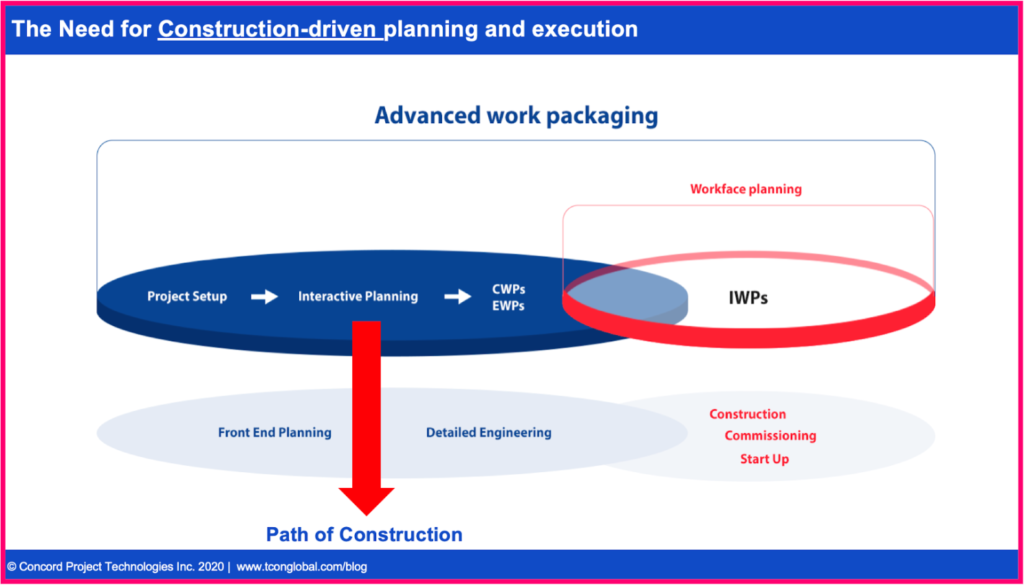A comprehensive guide to the purpose, design, and execution of a construction work package.
The best way to understand the purpose and value of a Construction Work Package is to compare it to the traditional way of managing construction, so let’s start there.
In most capital construction firms today, the bidding process begins as soon as engineering teams have delivered their initial documentation for a project. At this point, the executable elements of the project are not yet defined — far from it — but leadership teams finally have some initial technical details in-hand. In a good-faith effort to get the project off to a timely start, they initiate contractor negotiations.
In the absence of detailed plans and deliverables, however, contractors cannot make fact-based cost estimates or time commitments. As a result, negotiators default to a time-and-materials contract — after all, that’s the only kind of contract that makes sense given the limited available information. Unfortunately, time-and-materials contracts contain little inbuilt incentive for contractors to work quickly or efficiently. A cynic might say that it offers the opposite incentive, since the longer the project takes, the more money they make.
The ground has not even been broken, and the project leaders have unwittingly sown the seeds for delays and cost overruns.
There is a better way.
The Difference That Construction Work Packages Can Make
First, it is important to understand that Construction Work Packages (CWPs) are not produced during the construction phase. This is a widely held misconception. On the contrary, an organization that has applied the principles of Advanced Work Packaging (AWP) will develop CWPs long before initiating negotiations with contractors. Indeed, the CWP will form the basis of those negotiations.
On a well-run AWP project, the development of CWPs begins immediately after the detailed engineering phase, when the first Engineering Work Packages (EWPs) are complete. Using the EWPs and the Path of Construction for reference, the planning team works to create reasonably sized packages of work and to sequence them in a way that supports timely, predictable project completion. This is the ultimate goal of packaging work in advance.

Contractor negotiations begin only after the scope of construction is clear and the Construction Work Packages are complete. With detailed plans and deliverables in-hand, contractors can make fact-based cost estimates and time commitments. As a result, negotiators can enter into contracts that stipulate both the executable construction task and the deadline for completion.
This is the real power of packaging work in advance: it changes the contractual dynamics so that contractors have a strong incentive to collaborate, work efficiently and deliver on-time and on-budget. In short, it makes everything more predictable.
Who Builds CWPs? What Is Inside A CWP?
Generally speaking, a construction work package includes all of the information required for the elements therein to be completed. This includes:
- Comprehensive engineering information for the defined scope of work
- Timing and deadlines
- Labor requirements
- Constructability details
- Heavy Lifting requirements (cranes, etc.)
- Construction Strategy
- Anything else required by the contractor
The size of an average CWP varies, but a typical work package contains several months of work for a contractor organization. The Construction Manager is accountable for the CWPs, but they are built by a multi-disciplinary team that includes safety, engineering, quality, planning, scheduling, construction, engineering and other experts.
Contractor companies are responsible for building the Installation Work Packages (IWPs) that flow from the contracted CWPs. They may need to upgrade their project management capabilities or hire a Workface Planner. However, it is important that contractors remain in control of the construction execution and responsible for the outcomes. Efficient work improves their bottom line; delay and cost overruns do the opposite.
Ultimately, a well-designed Construction Work Package is one of the most important tools a team has for improving overall project predictability. Building on the Path of Construction (POC) and solid Engineering Work Packages, well-sequenced CWPs provide a solid foundation for on-time, on-budget project delivery.
If you’re interested in learning more about how Advanced Work Packaging and CWPs can improve your capital project construction outcomes, we are standing by to help. Click here to contact us.





